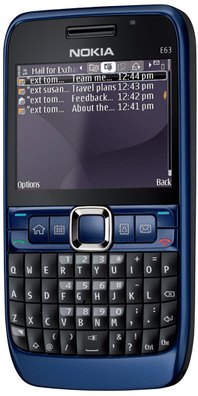 |
Please Enter IMEI Number:
|
Home / IMEI Checker / 35432904827733 Nokia E63
This is on-line service for checking and verification of IMEI numbers of Nokia E63 mobile phones, PDAs and other electronic devices. Each Nokia mobile cell phone, PDA or a device with a built-in GSM chipset has a unique 15 digit IMEI number. Based on this number, it is possilbe to check some information about the device, for instance brand and model, supported bands, operating system and special features.
|

|
||||||||||||||||||||||||
| Brand: | Nokia Browse Nokia devices |
| Manufacturer: | Nokia Browse all devices manufactured by Nokia |
| Hardware Designer: | Nokia |
| OEM ID: | RM-437 |
| Release Date: | November, 2008 |
Physical Attributes |
|
| Dimensions (width x height x depth): |
59 x 113 x 13 millimetres 2.3 x 4.4 x 0.5 inches |
| Bounding Volume: | 86.7 cubecentimetres |
| Mass: | 126 grams (battery included) |
Software Environment |
|
| Embedded Operating System: | Symbian OS 9.2 Series 60 3rd Edition Feature Pack 1 Browse devices running this OS |
| Kernel: | Symbian 9.2 |
Microprocessor, Chipset |
|
| CPU Clock: | 369 MHz |
| CPU: | ARM 1136JF-S Browse devices based on 1136JF-S |
| Width of Machine Word: | 32 bit |
| CPU Core: | ARM11 |
| Level 1 cache: | 16KiB data cache / 16 KiB instruction cache |
| Instruction Set: | ARMv6 |
Memory, Storage capacity |
|
| RAM type: | SDRAM |
| RAM capacity: | 128 MiB, 71MiB accessible |
| ROM type: | Flash EEPROM |
| ROM capacity: | 256 MiB, including 110MiB user-accessible non-volatile storage |
Graphical subsystem |
|
| Display Type: | color transflective TFT display |
| Display Color Depth: | 24 bit/pixel (16777216 scales) |
| Display Diagonal: | 2.4 " (60 millimetres) |
| Display Resolution: | 320 x 240 (76800 pixels) |
| Viewable Display Size: | 1.89 " x 1.42 " (48 x 36 millimetres) |
| Pixel density (dot pitch): | 169.3 pixel/inch (0.15 millimetre/pixel) |
Audio Subsystem |
|
| Audio Channel(s): | stereo sound |
| Digital/Analog Converter (Playing): |
16 bit resolution 48000 Hz holding frequency |
| Microphone(s): | mono sound |
| Loudspeaker(s): | mono sound |
| Audio Output: | 3.5mm plug |
Cellular Phone |
|
| Cellular Networks: | GSM850, GSM900, GSM1800, GSM1900, UMTS900 (B8), UMTS2100 (B1) |
| Cellular Data Links: | CSD, HSCSD, GPRS, EDGE, UMTS |
| Cellular Antenna: | Internal antenna |
| Call Alert: | 64 -chord melody (polyphonic) |
| Vibrating Alert: | Supported |
| Speakerphone : | Supported |
Control Peripherals |
|
| Positioning Device: | Not supported |
| Primary Keyboard: | Built-in QWERTY-type keyboard, 47 keys Automatic keyboard backlight (upon press of any key) |
| Directional Pad: | Four-way (with action button) |
| Scroll Wheel: | Optical trackpad |
Interfaces |
|
| Expansion Interfaces: | microSD, microSDHC, TransFlash Supports High Capacity (SD 2.0/HC) memory cards with capacity of up to 32GB |
| USB: | USB 2.0 client, Full-Speed (12Mbit/s) USB Series Micro-B (Micro-USB) connector |
| Bluetooth (802.15): | Bluetooth 2.0 + Enhanced Data Rate, Internal antenna |
| Wireless LAN/Wi-Fi (802.11): | IEEE 802.11b, IEEE 802.11g, 54 Mbit/s Internal antenna |
| Infrared Gate: | Not supported |
Multimedia Broadcast |
|
| Analog Radio: | FM radio (88-108 MHz) with RDS radio reciever Proprietary headset as antenna |
| Digital Media Broadcast: | Not supported |
Built-in Digital Camera |
|
| Sensor Type: | CMOS sensor |
| Resolution: | 1600 x1200 pixels (1.92MP) |
| Autofocus (AF): | Supported |
| Optical Zoom: | 1 x |
| Macro Mode: | Not supported |
| Built-in Flash: | mobile light (LED) |
| Camcorder: | 320x240 pixels , 15frame/sec |
| Recordable Image Formats: | JPG |
| Recordable Video Formats: | 3GP, MPEG4 |
Power Supply |
|
| Battery Technology: | Lithium-ion polymer battery |
| Battery Layout: | removable |
| Battery Capacity: | 1500 mAh - Click here for stronger battery |
Additional Details |
|
| Additional Features: |
|
| Related Page: | http://www.nokia.co.uk/A41419013 |
| Datasheet State: | Preliminary specifications |
| Datasheet Views: | 21348 times |
| Datasheet Added: | Nov 13, 08 12:36:05 |
- What is IMEI? The IMEI [International Mobile Equipment Identity] is a unique number to identify GSM, WCDMA, and iDEN mobile phones, as well as some satellite phones.
- What is PDA? The PDA [Personal Digital Assistant] is a small tablet computer which functions as a personal organizer, but provides Internet access, email and messanger.
- What is GSM? The GSM [Global System for Mobile communication] is a digital mobile telephony system that is used in Europe and Asia. GSM uses a variation of time division multiple access (TDMA) and is the most widely used of the three digital wireless telephony technologies (TDMA, GSM, and CDMA).
- What is ESN number? An ESN number is an Electronic Serial Number which is used to identify a specific CDMA cell phone. A CDMA cell phone generally does not use a SIM card to to identify and authenticate subscribers to the network.
this|
this|
this|
this|
this|
this|
this|
this|
this|
this|
this|
this|
this|
this|
this|
this|
this|
this|
this|
this|
this|
this|
this|
this|
this|

© 2024 GSMChecker.com is a free IMEI check tool that helps to identify any GSM-enabled device.
Reverse Phone Lookup | IMEI Check | Receive SMS Online | Phone Database | Background Check | Contact us | Terms | Sitemap

© 2024 GSMChecker.com is a free IMEI check tool that helps to identify any GSM-enabled device.
Reverse Phone Lookup | IMEI Check | Receive SMS Online | Phone Database | Background Check | Contact us | Terms | Sitemap

















